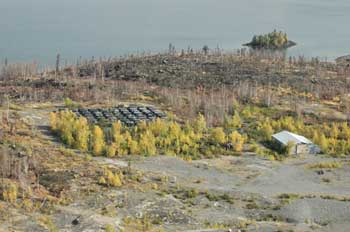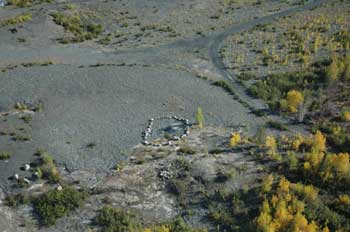Discovery Mine Remediation
History
Discovery Mine was an abandoned gold mine located on the western shore of Giauque Lake, approximately 80 km northeast of Yellowknife. The mine operated from 1949 to 1969 and at the time was one of the most profitable gold mines in the country.

Remediation Progress
- 1998-2000
- The preliminary phase of remediation was conducted. Routine environmental and geotechnical monitoring began with the end of the first phase of remediation. This short-term monitoring program ensured site conditions remained stable.
- 2005
- The bulk of the first phase remedial activities were carried out. The Phase I post-remediation Long Term Monitoring Plan was developed.
- 2006-2010
- Year 1 to year 5 of monitoring was carried out annually post-remediation. Following the Phase I Long Term Monitoring Plan, this program included biannual geotechnical monitoring, water quality, terrestrial and aquatic assessments.
- 2008
- The second phase of remediation of the Discovery Mine site was completed. This included sealing mine openings, decommissioning all the site buildings, addressing contaminated soil, stabilizing the borrow pit, and removal of hazardous waste.
- 2010
- A Comprehensive Remediation Performance Assessment Report was completed, which included a performance review of the geotechnical, water quality, terrestrial, and aquatic conditions on site. Based on this report, an interim monitoring plan was developed for future use.
- 2011-2015
- Interim monitoring took place every second year, for a total of 3 interim monitoring events.
- 2015
- Crown-Indigenous Relations and Northern Affairs Canada (CIRNAC) completed a site inspection to assess the site conditions after a forest fire passed through the site in 2014.
- 2016
- A Phase II Long Term Monitoring Plan is being developed and implemented for the year 10 sampling event scheduled to take place this fall.

More Information
The Mackenzie Valley Land and Water Board (MVLWB) issued the Water Licence and Land Use Permits required to conduct the remediation activities at Discovery Mine. The regulatory requirements required for these permits have all been met and are now closed. CIRNAC has reviewed the recommendations and monitoring results from the Performance Assessment Reports and is developing a Phase II long-term monitoring plan at a reduced scope and frequency for the site, given the reduced risks. Once the Phase II Long Term Monitoring Plan has been developed, the Discovery Mine Remediation Site will be monitored accordingly to continue verifying the environmental conditions onsite.
Remediation activities included:
- capping approximately 1.1 million tonnes of acid-generating tailings containing mercury;
- removing asbestos-containing materials;
- landfilling lead-based paint;
- removing hazardous building materials and demolishing structures in the town site;
- sealing mine openings; and
- excavating contaminated soils.